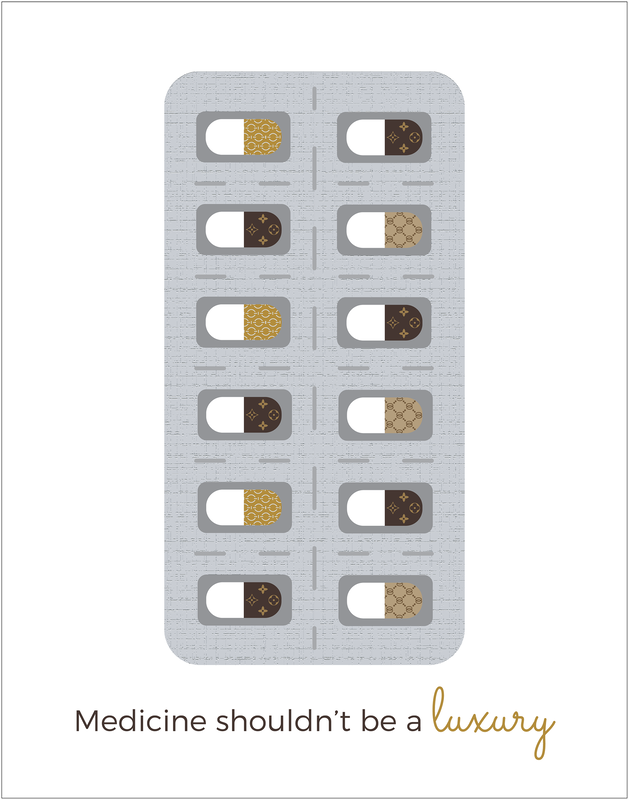|
January launches a fresh calendar year and all kinds of announcements. These may include updates from your insurer's drug formulary.
Pharmacy benefit managers (PBMs) inform you of medications which may have moved to a different tier (costing more) or may have been kicked off entirely (excluded). Sometimes these are mild changes. Patients request different prescriptions to match the formulary preference and see how their body responds. When a patient needs an excluded medication the process of prior authorization begins. PBMs present this as a great situation to save everyone money. In reality, it is a time-suck and a stressor on clinic staff and patients. There is a rolling-of-the-dice suspense each time. Will the exclusion be upheld? The collage "Not a Party After All." is a response to the shifting formulary. Good luck to everyone currently in such a process. Hang in there. By the way, if you haven't seen this Brian David Gilbert video "Health Insurance Terms," I recommend it. This is through the podcast episode An Arm and A Leg.
0 Comments
The New York Times op-ed illustration by Erre Gálvez with photographs by D&C Photography, Javier Zayas and milosluz, via Getty Images is a fine accompaniment for “The Next Anti-Abortion Tactic: Attacking the Spread of Information.” Collage lends itself well to this topic.
The art ran with a December 4, 2022 article by Michele Goodwin and Mary Ziegler. Are there not enough barriers to medicines? Goodwin and Ziegler point out “More Americans lack access to abortion than before, and abortion access has everything to do with access to information.” (The online article appeared on December 3.) I appreciate the artful graphics used to show how complicated and out-of-date our current patent laws are. This is just one example of the clean, clear illustrations from The Initiative for Medicines, Access, and Knowledge (I-MAK).
The nonprofit was founded in 2006 by health justice lawyers Priti Krishtel and Tahir Amin. Learn more about how their colleagues strive for a more just patent system through structural change on the I-MAK site. Download the brief Pharmaceutical Patent Myths, from which this graphic comes, here. Krishtel has been named one of 25 MacArthur Fellows for “Exposing the inequities in the patent system to increase access to affordable, life-saving medications on a global scale.” (see her MacArthur Foundation profile). Awardees were announced on October 12, 2022. I am thrilled and relieved that her work is receiving such deserved support. NPR’s global health and development blog Goats and Soda also does a good job highlighting her goals and the sheer necessity of improving our patent system. This Op-Ed first appeared in The Gettysburg Times September 8, 2022
This bumper sticker isn’t necessarily meant for public health, but “EVERYONE does better when EVERYONE does better” fits perfectly when we talk about access to healthcare and access to essential medicines. So does this abstract ink drawing from Eric H. Crump’s series. I happen to come into possession of both the artwork and the bumper sticker in August when the Inflation Reduction Act was signed into law. We are connected. We are interdependent. The Johns Hopkins Bloomberg School of Public Health defines public health this way: “In the medical field, clinicians treat diseases and injuries one patient at a time. In public health, researchers, practitioners, and educators prevent disease and injury at the community and population level. We identify the causes of disease and disability, and we implement large-scale solutions.” The issue of drug pricing is both a public health issue and an individual medical issue. Public health can seem abstract because it is concerned with populations, but connections are connections, and every population is made up of real people. The senators and house members who voted against the Inflation Reduction Act voted against the needs of real people. For 19 years Medicare has been blocked from any kind of negotiating prescription drug costs. According to the White House News Release from August 15, the pharmaceutical industry has already spent $187 million on lobbying in 2022. That is $187 million in this yet-unfolding year to put obstacles between real people and the drugs they need. In a recent NPR Weekend Edition author interview about A History of Present Illness, Dr. Anna DeForest zeroed in on a truth about those who hold so much power they don’t even notice it. “I realized something about power, which is that it’s not a feeling. It is the absence of obstacles.” This is not a partisan issue. It is a voter issue. It is a public health issue linking us as taxpayers and patients and healthcare providers and members of congress in dramatic and subtle ways. In November, consider where candidates stand on access to medicines. Notice who includes you and who excludes you. Notice who would rather pay for obstacles than for access. Notice who wants everyone to do better. Katy Giebenhain is a member of the Gettysburg Area DFA Healthcare Task Force. A folksong is a song of the people.
A folksong is truth-telling with a chorus. I've thought for a long time that barriers to essential medicines deserve a contemporary folksong. Here is a reminder of the situation we (the entire country) find ourselves in. I thank David Wilcox for his unmistakable voice and songwriting. "Broken by Design," with music and lyrics © David Wilcox, names the deliberate complexity of drug pricing. The August 15, 2022 White House news release "By the Numbers: The Inflation Reduction Act" includes the fact that there were three times the number of lobbyists from pharmaceutical companies as Members of Congress in 2021. We can do better. They can do better. There is reason to hope. I have experienced July 4 in the U.S. and while living overseas. It is interesting to get perspective on your country of origin when you no longer live there. It is equally interesting to not recognize your country when you are physically "back home." Today, on the heels of the Supreme Court shutting down official access to abortion (which access to essential medicines includes), I can't help but think of all the kinds of access we celebrate on this holiday. I've dug up an old poster I designed with the last words of each line from the Star Spangled Banner. We can do better. We can trust each other more when we respect each other more. We certainly can trust women and their healthcare providers more.
I am pleased to have a mixed-media piece included in the June 2022 issue of American Journal of Nursing (AJN). "American Drug Formulary Exclusions" appears in the Art of Nursing column.
Along with the other articles is a perceptive column about the reality of self-care for nurses by Emily Stice Laker. I also appreciate the tribute to the late Dr. Paul Farmer which quotes his 2018 Harvard Gazette interview. Farmer points with precision to our problem with access to medicines (and healthcare in general). It is an attitude that steers policy and individual decisions: "We are socialized for scarcity for other people." He asserted that everyone has a right to first-class healthcare. I was happy for the chance to make it down to the Baltimore Museum of Art to see the Joan Mitchell exhibit, and Guarding the Art (curated by BMA guards). It was something in the bookstore, though, that was the zinger of the visit. Leafing through Posters for Change: Tear, Paste, Protest, a Princeton Architectural Press title from 2018 brought me to Valerie Joly Chock's design for the poster "Not a Luxury." This is what good visual design can do. Here, the right words and the right image speak a truth which has only increased since the publication of the book. Posters for Change gathers 50 posters responding to social and political issues. They can be torn out from the binding.
In the description, Joly Chock says her poster's healthcare focus "...uses patterns similar to those of luxurious brands to convey how expensive some medications are. The poster communicates that medicine should not be a luxury to which only the wealthy have access." Amen to that. See more of her work here. The New York Times Editorial Board presented a constructive editorial in the April 16, 2022 issue. I appreciate the accompanying illustration, too. "Save America's Patent System" outlines how the system could function better if we enforce existing standards, improve the process for challenging bad patents, eliminate potential conflicts of interest, collaborate with other agencies and let the public participate. "And for all the hand-wringing over how to lower prescription drug costs in recent years, little has been said about the patent system or its many failings. Put simply: The United States Patent and Trademark Office is in dire need of reform."
"Wolves in Sheep's Clothing - Big Pharma Lobbyists" appears in the Spring, 2022 issue of The Northern Virginia Review. Last year was a record-breaking one for industry spending on lobbying. View the full issue of the journal below. I recommend Elisabeth Rosenthal's article "Public Opinion Is Unified on Lowering Drug Prices. Why Are Leaders Settling for Less?" from Kaiser Health News for a useful description of the topic.
|
BP&theBAn arts blog advocating for access to essential medicines Archives
March 2024
Categories |












 RSS Feed
RSS Feed